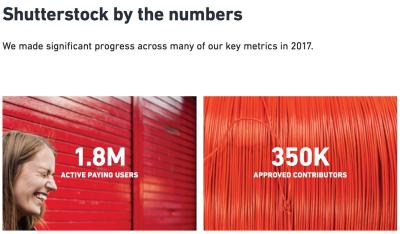Thinking about turning your creative skills into cash? Shutterstock is one of the biggest platforms out there for photographers, videographers, and graphic designers to showcase and sell their work. Whether you’re an amateur with a passion for capturing moments or a professional looking to diversify your income, Shutterstock offers a fantastic opportunity. The platform not only helps you reach a global audience but also provides a straightforward way to earn money every time someone downloads your content. Let’s explore how you can tap into this revenue stream and start earning as a
Step-by-Step Guide to Becoming a Shutterstock Contributor

Getting started as a Shutterstock contributor might seem a bit daunting at first, but it’s actually quite simple. Here’s a step-by-step guide to help you navigate the process:
1. Sign Up and Create an Account
- Visit the Shutterstock Contributor Portal.
- Click on the “Join Now” or “Sign Up” button.
- Fill out the registration form with your details—name, email, and password.
- Read and agree to the contributor agreement—you’re officially on your way!
2. Prepare Your Content
Before uploading, make sure your content meets Shutterstock’s quality standards:
- High-resolution images (preferably 4MP or higher).
- Unique and original content—avoid copyrighted material.
- Properly edited and color-corrected images.
- Clear, descriptive titles and tags to help your content get discovered.
3. Upload Your Files
Once your content is ready:
- Log into your contributor dashboard.
- Click the “Upload” button and select your files.
- Add relevant metadata—titles, keywords, and descriptions to optimize searchability.
- Choose appropriate categories to help your work reach the right buyers.
- Review your uploads and submit for review.
4. Submit for Review
Shutterstock has a review process to ensure quality standards are met. After submission:
- Your content will be evaluated by their quality team—this usually takes a few days.
- If approved, your work goes live and becomes available for licensing.
- If rejected, you’ll receive feedback so you can improve and resubmit.
5. Promote and Monitor Your Portfolio
Once your content is live:
- Share your portfolio on social media to attract more buyers.
- Regularly upload fresh content to increase your earning potential.
- Track your sales and analytics through the contributor dashboard.
- Optimize your keywords and descriptions based on performance data.
Becoming a successful Shutterstock contributor takes patience and consistency, but with quality content and a strategic approach, you can turn your passion into a steady income stream. Happy uploading!
Preparing High-Quality Content for Submission
So, you want to earn money as a contributor on Shutterstock? Great choice! But before you start uploading your work, it’s crucial to focus on creating high-quality content that stands out. After all, the platform gets thousands of submissions daily, and only the best make it to the marketplace.
First things first—quality over quantity is the name of the game. Shutterstock’s reviewers are pretty strict about the standards they uphold, so your content needs to be polished and professional. Here are some tips to help you prepare top-notch content:
- Use a Good Camera or Equipment: Whether you’re into photography, illustrations, or videos, investing in decent gear can make a huge difference. Sharp images with good resolution catch the eye, while clear audio and high-definition videos are more appealing to buyers.
- Focus on Composition and Lighting: Well-composed shots with proper lighting look more professional. Avoid harsh shadows or overexposed areas. Take your time to set up each shot or design your artwork thoughtfully.
- Pay Attention to Technical Details: Make sure your files are properly formatted, correctly sized, and meet resolution requirements. For photography, a minimum of 4 MP (megapixels) is often recommended, with some categories demanding higher resolutions.
- Enhance Your Content: Use editing software to fine-tune your images or videos. Adjust brightness, contrast, and color balance to make your work pop. For illustrations, ensure clean lines and consistent styles.
- Be Original and Creative: Unique content that offers something different tends to perform better. Think about current trends, but also add your personal touch to make your submissions stand out.
Remember, every piece of content you submit is a reflection of your professionalism. Take your time to perfect each file. When you’re happy with your work, double-check that it’s free of watermarks, unwanted objects, or distractions. High-quality content not only increases your chances of acceptance but also boosts your potential earnings through higher licensing fees and better exposure.
Understanding Shutterstock’s Submission Guidelines and Requirements
Now that you’ve got your content ready, it’s essential to understand Shutterstock’s submission guidelines. Following these rules helps ensure your work gets accepted smoothly and reduces the risk of rejection. Plus, it’s the first step toward building a successful contributor profile.
Here’s a quick overview of key guidelines you should keep in mind:
| Category | Important Requirements |
|---|---|
| File Formats | Photos: JPEG, RGB color profile, 8-bit. Videos: MOV or MP4 formats. Illustrations: AI, EPS, or JPEG. |
| Resolution | Minimum of 4 MP for images; higher resolutions are preferred. Videos should be at least HD (720p) or 4K if possible. |
| Content Quality | All files must be sharp, well-lit, and free of noise or artifacts. Avoid over-compression or pixelation. |
| Model & Property Releases | If your content features recognizable people, private property, or trademarks, you need to provide appropriate releases. |
| Content Restrictions | No copyrighted material, no offensive content, and avoid images that could be considered controversial or inappropriate. |
| Metadata | Accurate and descriptive keywords, titles, and descriptions are essential for discoverability and licensing. |
Another important aspect is understanding the review process. Shutterstock’s review team carefully evaluates each submission for quality, adherence to guidelines, and originality. If your content gets rejected, don’t be discouraged! Review the feedback, make necessary adjustments, and try again. Persistence is key.
Lastly, keep yourself updated with any changes in guidelines or new requirements. Shutterstock often updates its policies, and staying informed will help you avoid common pitfalls and maximize your earning potential.
By thoroughly understanding and following these guidelines, you’ll be on your way to building a successful contributing career on Shutterstock. Happy uploading!
Tips for Optimizing Your Content for Better Visibility and Sales
So, you’ve uploaded some fantastic images and videos to Shutterstock — great job! But what’s next? The truth is, with thousands of contributors out there, it’s essential to optimize your content to stand out and boost your sales. Here are some practical tips to help your work get the attention it deserves:
Use Descriptive and Relevant Titles
Your titles are the first thing buyers see, so make them clear, descriptive, and relevant. Instead of vague titles like “Beautiful Scene,” go for something specific like “Sunset Over Mountain Lake with Reflection.” This helps search engines and buyers find your work more easily.
Write Detailed and Accurate Descriptions
Descriptions should give context and highlight the key elements of the image or video. Include keywords naturally — think about what someone might search for. For example, if your photo features a “businesswoman giving a presentation,” mention that explicitly, along with details like location, mood, or activity.
Select Appropriate Keywords
Keywords are crucial for discoverability. Use a mix of broad and specific tags, but avoid keyword stuffing. Think about what potential buyers might search for, and include relevant terms like colors, emotions, subjects, and concepts. Shutterstock allows up to 50 keywords, so make good use of them!
Choose the Right Categories and Subcategories
Proper categorization helps your content appear in the right searches. Take a moment to select the most accurate categories, and if available, subcategories. This small step makes a big difference in ensuring your work reaches the right audience.
Upload High-Quality, Well-Cropped Content
Quality is king. Make sure your images are sharp, well-exposed, and free of noise or distractions. For videos, ensure good lighting and steady shots. Proper cropping and composition make your content more appealing and professional-looking, increasing the likelihood of sales.
Stay Consistent and Keep Uploading
The more quality content you upload regularly, the better your chances of getting noticed. Consistency helps build your portfolio and keeps your profile active, which algorithms favor when showcasing content to potential buyers.
How to Maximize Your Earnings on Shutterstock
Maximizing your earnings isn’t just about uploading pretty pictures — it’s about strategic effort and understanding how the platform works. Here are some tips to help you boost your income as a Shutterstock contributor:
Focus on Popular and Evergreen Topics
- Trending themes: Keep an eye on current trends like remote work, sustainability, or health. Creating content around these themes can attract more searches.
- Evergreen subjects: Think timeless topics like business, education, family, and nature. These always have steady demand.
Offer a Variety of Content Types
Don’t rely solely on photos. Videos, vectors, and illustrations can diversify your portfolio and open up multiple revenue streams. Different clients look for different formats, so providing variety can increase your chances of sales.
Leverage Your Best Content
Identify your top-performing images or videos and promote them within your portfolio. Sometimes, a small tweak in keywords or description can give a boost. Keep an eye on your analytics to see what sells best and create similar content.
Participate in Shutterstock Promotions and Challenges
Shutterstock occasionally runs promotional campaigns and creative challenges. Participating can give your work additional exposure, leading to more sales and higher visibility.
Engage with the Contributor Community
Join Shutterstock forums or social media groups to learn tips, get feedback, and stay updated on platform changes. Networking can also open opportunities for collaborations or special projects that boost your earnings.
Optimize Your Portfolio for Recurring Sales
Build collections around specific themes or niches. Customers often buy multiple related assets, so having well-organized collections can encourage repeat purchases.
Consider Licensing Options
Shutterstock offers different licensing options that can affect your earnings. Understand how extended licenses work and when to offer exclusive content, which can command higher prices.
At the end of the day, earning more on Shutterstock is about combining quality, strategic keywording, consistent uploads, and engaging with the platform’s features. Keep learning, experimenting, and refining your approach — your hard work will pay off!
Managing Your Portfolio and Tracking Your Income
Once you start uploading your amazing images and videos to Shutterstock, it’s essential to stay organized and keep an eye on how your work is performing. Managing your portfolio effectively not only helps you stay motivated but also ensures you’re maximizing your earning potential.
First off, regularly review your portfolio. Shutterstock offers a dashboard where you can see which images are selling well, which aren’t, and how much you’re earning from each. This is your chance to identify your best-performing content and understand what buyers are looking for.
Here are some tips for managing your portfolio:
- Update and refresh: Periodically add new content to keep your portfolio lively and relevant. Trends change, so staying current can give you an edge.
- Remove underperformers: If certain images or videos aren’t selling after a while, consider removing or replacing them with new ones.
- Organize your files: Use descriptive filenames and keywords to make your content easy to find and improve its discoverability.
- Analyze your sales data: Use the earnings reports to see which types of content generate the most income. Are your landscapes selling better than your portraits? Focus on what works!
Tracking your income is just as important as managing your portfolio. Shutterstock provides detailed reports that break down your earnings by date, content type, and download type. Regularly reviewing these reports helps you understand your income streams and set realistic goals.
To make tracking easier:
- Set aside time weekly or monthly to review your sales data.
- Keep a spreadsheet or use accounting software to monitor your cumulative earnings and expenses.
- Note which keywords or topics lead to more downloads to guide your future content creation.
Remember, earning passive income takes patience. By staying organized and attentive to your portfolio and earnings, you can identify what’s working, optimize your efforts, and steadily grow your income on Shutterstock.
Common Challenges and How to Overcome Them as a Shutterstock Contributor
Getting started as a contributor on Shutterstock is exciting, but it’s not without its hurdles. Many new contributors face similar challenges, from standing out in a crowded marketplace to dealing with inconsistent income. The good news? With a little strategy and persistence, you can overcome these obstacles and thrive.
Challenge 1: Competition is fierce. Shutterstock hosts millions of images, so making your work stand out can be tough. To combat this, focus on creating unique, high-quality content that fills gaps in the market. Research trending topics and niche categories where competition might be lower but demand is high.
Challenge 2: Keeping up with trends. Visual trends change rapidly. Staying current requires ongoing learning and adaptation. Follow industry blogs, social media trends, and popular content themes to keep your portfolio fresh and relevant.
Challenge 3: Inconsistent sales. It’s common to experience fluctuating income, especially when starting out. The key is persistence. Keep uploading new content regularly and optimize your keywords to improve discoverability. Over time, consistent effort pays off.
Challenge 4: Understanding copyright and licensing. Misunderstandings around licensing can lead to rejected submissions or legal issues. Always ensure you have the rights to all elements in your images and videos. Read Shutterstock’s contributor guidelines carefully, and when in doubt, opt for model releases or property releases where necessary.
Here are some practical tips to overcome these challenges:
- Invest in quality: Use good equipment and editing software to produce sharp, appealing content.
- Learn from others: Study top contributors’ portfolios to understand what works well.
- Stay organized: Keep track of your submissions, sales, and keywords to identify patterns and areas for improvement.
- Be patient and persistent: Success on Shutterstock often takes time. Keep uploading, learning, and adapting.
Remember, every challenge is an opportunity to learn and grow. With dedication and the right approach, you’ll find your niche and build a steady stream of income as a Shutterstock contributor. Keep pushing forward, and don’t get discouraged by setbacks — they’re just part of the journey to becoming a successful contributor.
Additional Resources and Tips for Success in Stock Photography
Embarking on a journey to become a successful stock photographer requires continuous learning and strategic effort. To enhance your skills and maximize your earning potential on Shutterstock, consider exploring the following resources and tips:
- Online Courses and Tutorials: Platforms like Udemy, Skillshare, and LinkedIn Learning offer specialized courses on photography techniques, editing skills, and market trends. Investing in these can help you improve the quality and variety of your submissions.
- Photography Communities and Forums: Join communities such as Flickr, 500px, or Shutterstock Contributor Forums to connect with other photographers. Sharing feedback and insights can inspire new ideas and help you stay updated on industry standards.
- Stay Informed on Trends: Regularly review top-selling images on Shutterstock and other stock sites to identify popular themes, styles, and subjects. Adapt your shoots to match current demand while maintaining your unique artistic voice.
- Optimize Your Portfolio: Use relevant keywords, detailed descriptions, and accurate categories to improve your images’ discoverability. Quality images with proper metadata attract more buyers and increase sales opportunities.
- Consistency and Diversification: Upload new images regularly to keep your portfolio fresh. Diversify your subjects and styles to reach broader audiences and reduce dependency on a single niche.
Remember, success in stock photography is a blend of technical skill, market awareness, and perseverance. Continuously hone your craft, leverage available resources, and stay adaptable to evolving trends to thrive as a Shutterstock contributor.


